System Analysis Report: Cloud Based Solutions for Healthcare Sector
VerifiedAdded on 2023/06/03
|10
|2611
|126
Report
AI Summary
This report provides a system analysis of cloud-based solutions, particularly within the context of healthcare and the Headspace NewAccess project. It delves into the various aspects of cloud computing, including the unique features of cloud services such as on-demand self-service, broad network access, resource pooling, rapid elasticity, and measured services. The report explores the different cloud service models like IaaS, PaaS, and SaaS and their applications. It also discusses non-functional requirements, including product, source code, and critical system requirements, emphasizing reliability, performance, security, and usability. The report further reviews cloud-based solutions, their strengths, weaknesses, and integration with existing systems, along with the SDLC approaches, including predictive and adaptive methodologies, considering their pros and cons. The analysis considers data security and ownership aspects, making it relevant for organizations considering cloud adoption.
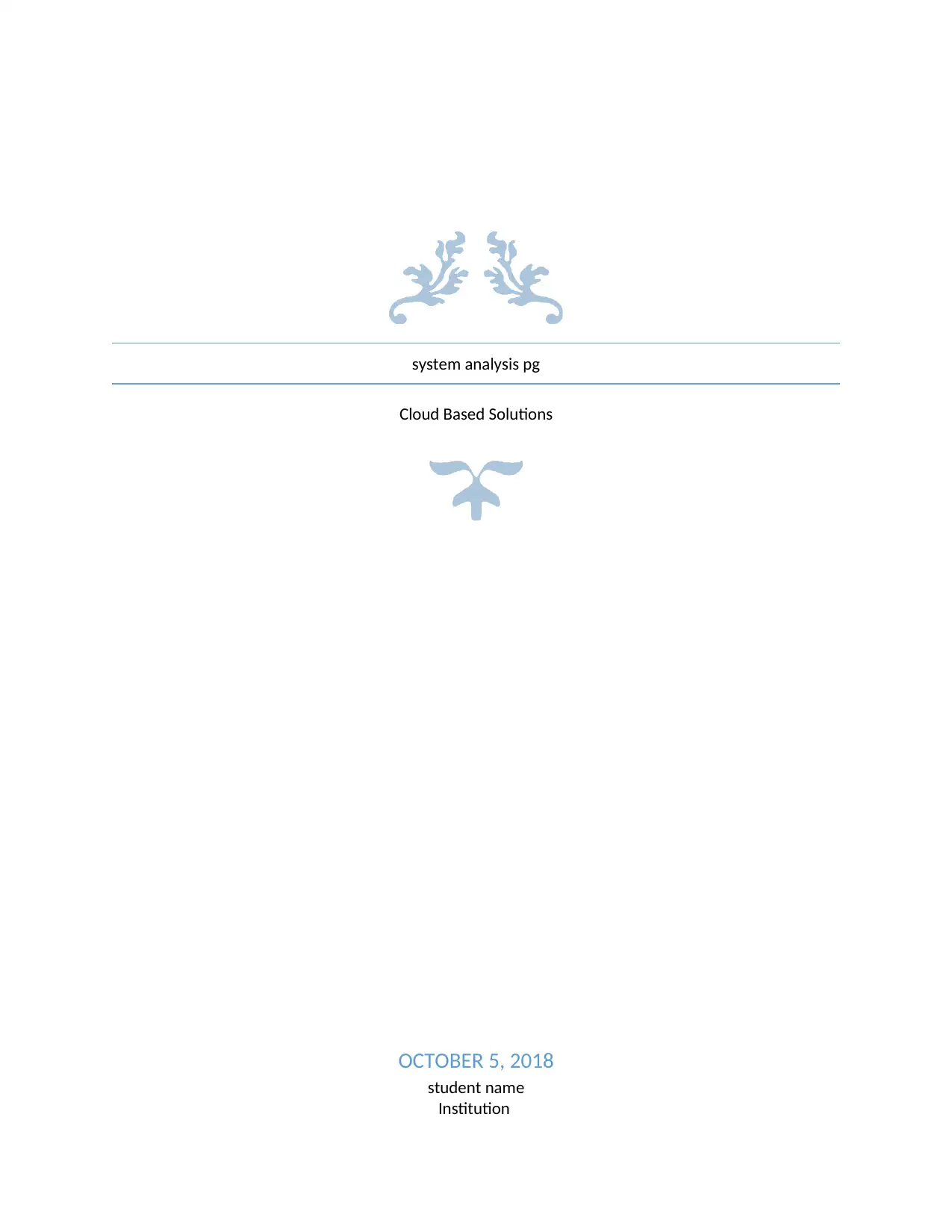
system analysis pg
Cloud Based Solutions
OCTOBER 5, 2018
student name
Institution
Cloud Based Solutions
OCTOBER 5, 2018
student name
Institution
Paraphrase This Document
Need a fresh take? Get an instant paraphrase of this document with our AI Paraphraser
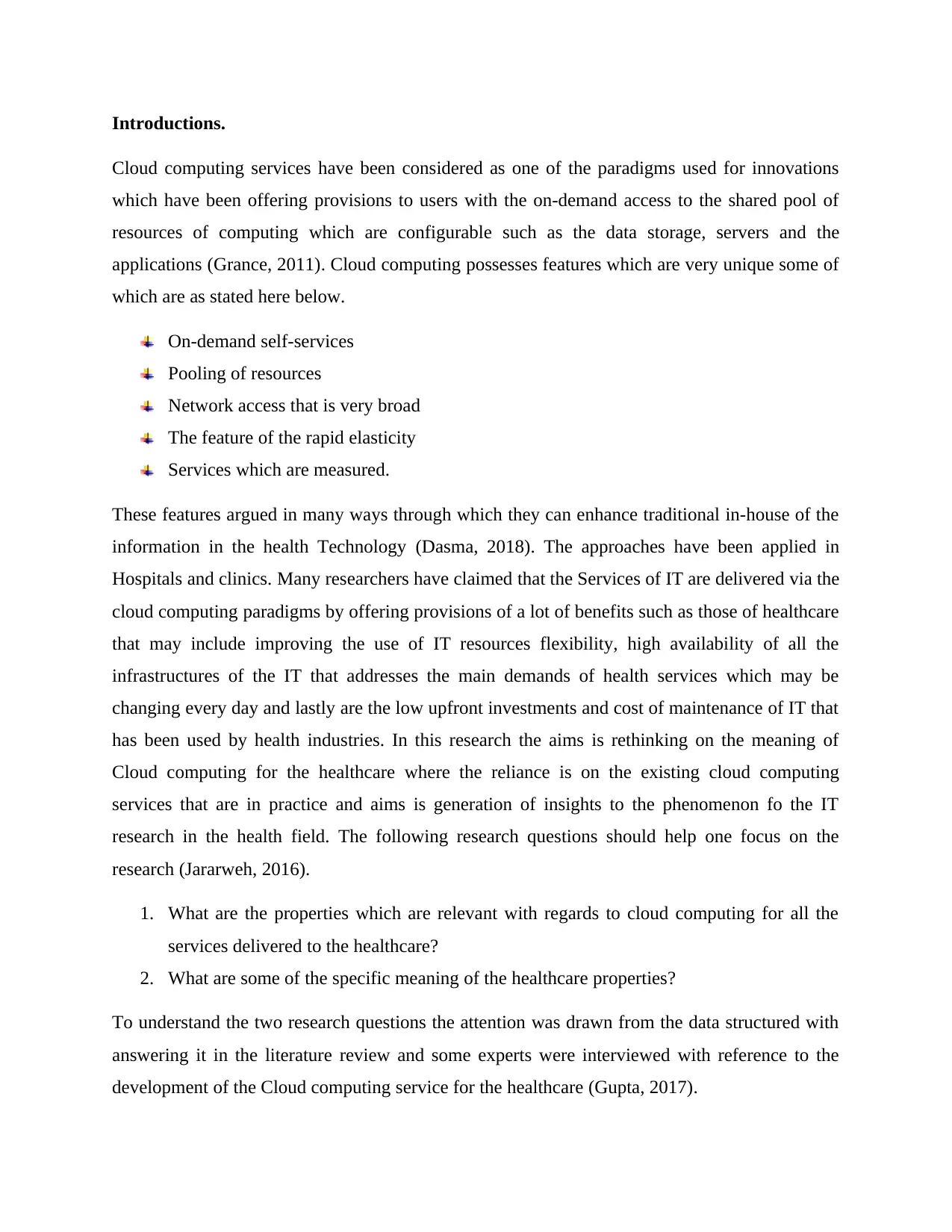
Introductions.
Cloud computing services have been considered as one of the paradigms used for innovations
which have been offering provisions to users with the on-demand access to the shared pool of
resources of computing which are configurable such as the data storage, servers and the
applications (Grance, 2011). Cloud computing possesses features which are very unique some of
which are as stated here below.
On-demand self-services
Pooling of resources
Network access that is very broad
The feature of the rapid elasticity
Services which are measured.
These features argued in many ways through which they can enhance traditional in-house of the
information in the health Technology (Dasma, 2018). The approaches have been applied in
Hospitals and clinics. Many researchers have claimed that the Services of IT are delivered via the
cloud computing paradigms by offering provisions of a lot of benefits such as those of healthcare
that may include improving the use of IT resources flexibility, high availability of all the
infrastructures of the IT that addresses the main demands of health services which may be
changing every day and lastly are the low upfront investments and cost of maintenance of IT that
has been used by health industries. In this research the aims is rethinking on the meaning of
Cloud computing for the healthcare where the reliance is on the existing cloud computing
services that are in practice and aims is generation of insights to the phenomenon fo the IT
research in the health field. The following research questions should help one focus on the
research (Jararweh, 2016).
1. What are the properties which are relevant with regards to cloud computing for all the
services delivered to the healthcare?
2. What are some of the specific meaning of the healthcare properties?
To understand the two research questions the attention was drawn from the data structured with
answering it in the literature review and some experts were interviewed with reference to the
development of the Cloud computing service for the healthcare (Gupta, 2017).
Cloud computing services have been considered as one of the paradigms used for innovations
which have been offering provisions to users with the on-demand access to the shared pool of
resources of computing which are configurable such as the data storage, servers and the
applications (Grance, 2011). Cloud computing possesses features which are very unique some of
which are as stated here below.
On-demand self-services
Pooling of resources
Network access that is very broad
The feature of the rapid elasticity
Services which are measured.
These features argued in many ways through which they can enhance traditional in-house of the
information in the health Technology (Dasma, 2018). The approaches have been applied in
Hospitals and clinics. Many researchers have claimed that the Services of IT are delivered via the
cloud computing paradigms by offering provisions of a lot of benefits such as those of healthcare
that may include improving the use of IT resources flexibility, high availability of all the
infrastructures of the IT that addresses the main demands of health services which may be
changing every day and lastly are the low upfront investments and cost of maintenance of IT that
has been used by health industries. In this research the aims is rethinking on the meaning of
Cloud computing for the healthcare where the reliance is on the existing cloud computing
services that are in practice and aims is generation of insights to the phenomenon fo the IT
research in the health field. The following research questions should help one focus on the
research (Jararweh, 2016).
1. What are the properties which are relevant with regards to cloud computing for all the
services delivered to the healthcare?
2. What are some of the specific meaning of the healthcare properties?
To understand the two research questions the attention was drawn from the data structured with
answering it in the literature review and some experts were interviewed with reference to the
development of the Cloud computing service for the healthcare (Gupta, 2017).

Cloud Computing Knowledge in Healthcare
Cloud computing is simply an innovation for most healthcare organizations. In healthcare
industry there are three major types of innovations observed.
1. Innovation that focuses on the manner where clients can access their health care and the
related fund services when need be.
2. Innovation that applies technology in improving the services and products of care
3. Innovation that is used for generation of models of business
Cloud computing has provided further three service models named as Software as a Service
(SaaS), Platform as a Service (PaaS) and Infrastructure as a Service (IaaS) and where all of the
three models all of them are web-based. Cloud computing can be termed to be delivering the IT
resources which are said to be fundamental such as concept of processing, data storage which is
achieved by the third model service which is Infrastructure as a Service (IaaS) and other
platforms which work together with tools such as programming languages, libraries that has
offered provisions to users with regards to developing and deploying the said or needed software
where the model service applied is the Platform as a Service (PaaS). Cloud computing have been
known for providing the ready-to-use software applications which are able to run efficiently in
the infrastructures of cloud computing services as provides by the open use of such service in the
general public.
Cloud computing has relied on different models for deployment in offering provisions of
Information Technology Services. In the public cloud , cloud computing services infrastructures
has provided for open use of such to be applied and used in general public. In the private
company infrastructure the cloud is provisioned in the manner that there will be like use of single
organization or organizations groups who have a policy and a contract with the vendor. Lastly is
that the hybrid cloud can be a combination of two or more mentioned preceding models for
deployment. In the public clouds if there exist in the off premises of the users of the cloud,
private and clouds in the community may exist on the or off the existing premises. The research
on cloud computing services applied the concept of aiming at organizing all the knowledge about
the cloud computing and it conceptualization with reference to Healthcare.
Cloud computing is simply an innovation for most healthcare organizations. In healthcare
industry there are three major types of innovations observed.
1. Innovation that focuses on the manner where clients can access their health care and the
related fund services when need be.
2. Innovation that applies technology in improving the services and products of care
3. Innovation that is used for generation of models of business
Cloud computing has provided further three service models named as Software as a Service
(SaaS), Platform as a Service (PaaS) and Infrastructure as a Service (IaaS) and where all of the
three models all of them are web-based. Cloud computing can be termed to be delivering the IT
resources which are said to be fundamental such as concept of processing, data storage which is
achieved by the third model service which is Infrastructure as a Service (IaaS) and other
platforms which work together with tools such as programming languages, libraries that has
offered provisions to users with regards to developing and deploying the said or needed software
where the model service applied is the Platform as a Service (PaaS). Cloud computing have been
known for providing the ready-to-use software applications which are able to run efficiently in
the infrastructures of cloud computing services as provides by the open use of such service in the
general public.
Cloud computing has relied on different models for deployment in offering provisions of
Information Technology Services. In the public cloud , cloud computing services infrastructures
has provided for open use of such to be applied and used in general public. In the private
company infrastructure the cloud is provisioned in the manner that there will be like use of single
organization or organizations groups who have a policy and a contract with the vendor. Lastly is
that the hybrid cloud can be a combination of two or more mentioned preceding models for
deployment. In the public clouds if there exist in the off premises of the users of the cloud,
private and clouds in the community may exist on the or off the existing premises. The research
on cloud computing services applied the concept of aiming at organizing all the knowledge about
the cloud computing and it conceptualization with reference to Healthcare.
⊘ This is a preview!⊘
Do you want full access?
Subscribe today to unlock all pages.

Trusted by 1+ million students worldwide

Non-functional Requirements
Non-functional requirements defines the overall qualities or the attributes of the resulting system.
They are applied by placing restrictions on the services or the developed products, the process of
development and thus specifying the constraints which are external that must be met by the
product. Some of the examples that cloud computing services should meet are such as the safety,
usability, security, reliability and the requirements such as performance (Velusamy, 2009).
In the choosing of all the non-functional requirements the first thing that should be ensured is
that data is protected from all the access that are not authorized. In case Healthcare opts to
choose any of the cloud computing models then it is their mandate to know who to give the
access to the protected data. Conventionally it is considered as one of non-functional requirement
as will not specify the system functionality and its supposed to provided when stating the
requirements. The sytem is therefore designed in the manner that the users must identify
themselves in cases when they want to login using their names and passwords. It is only the users
who have access to cloud computing service will have access to the data in the system.
Non-functional requirements defines the overall qualities or the attributes of the resulting system.
They are applied by placing restrictions on the services or the developed products, the process of
development and thus specifying the constraints which are external that must be met by the
product. Some of the examples that cloud computing services should meet are such as the safety,
usability, security, reliability and the requirements such as performance (Velusamy, 2009).
In the choosing of all the non-functional requirements the first thing that should be ensured is
that data is protected from all the access that are not authorized. In case Healthcare opts to
choose any of the cloud computing models then it is their mandate to know who to give the
access to the protected data. Conventionally it is considered as one of non-functional requirement
as will not specify the system functionality and its supposed to provided when stating the
requirements. The sytem is therefore designed in the manner that the users must identify
themselves in cases when they want to login using their names and passwords. It is only the users
who have access to cloud computing service will have access to the data in the system.
Paraphrase This Document
Need a fresh take? Get an instant paraphrase of this document with our AI Paraphraser
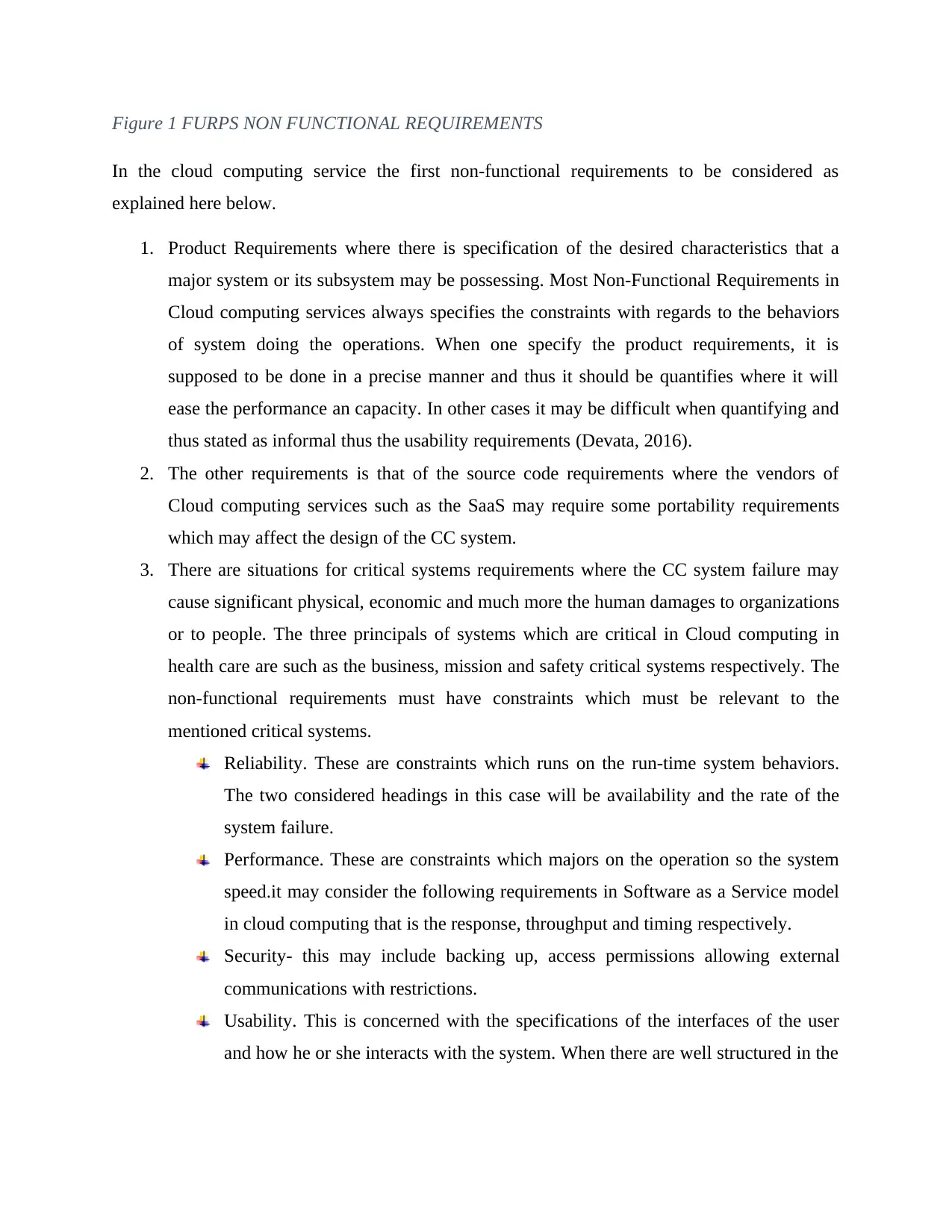
Figure 1 FURPS NON FUNCTIONAL REQUIREMENTS
In the cloud computing service the first non-functional requirements to be considered as
explained here below.
1. Product Requirements where there is specification of the desired characteristics that a
major system or its subsystem may be possessing. Most Non-Functional Requirements in
Cloud computing services always specifies the constraints with regards to the behaviors
of system doing the operations. When one specify the product requirements, it is
supposed to be done in a precise manner and thus it should be quantifies where it will
ease the performance an capacity. In other cases it may be difficult when quantifying and
thus stated as informal thus the usability requirements (Devata, 2016).
2. The other requirements is that of the source code requirements where the vendors of
Cloud computing services such as the SaaS may require some portability requirements
which may affect the design of the CC system.
3. There are situations for critical systems requirements where the CC system failure may
cause significant physical, economic and much more the human damages to organizations
or to people. The three principals of systems which are critical in Cloud computing in
health care are such as the business, mission and safety critical systems respectively. The
non-functional requirements must have constraints which must be relevant to the
mentioned critical systems.
Reliability. These are constraints which runs on the run-time system behaviors.
The two considered headings in this case will be availability and the rate of the
system failure.
Performance. These are constraints which majors on the operation so the system
speed.it may consider the following requirements in Software as a Service model
in cloud computing that is the response, throughput and timing respectively.
Security- this may include backing up, access permissions allowing external
communications with restrictions.
Usability. This is concerned with the specifications of the interfaces of the user
and how he or she interacts with the system. When there are well structured in the
In the cloud computing service the first non-functional requirements to be considered as
explained here below.
1. Product Requirements where there is specification of the desired characteristics that a
major system or its subsystem may be possessing. Most Non-Functional Requirements in
Cloud computing services always specifies the constraints with regards to the behaviors
of system doing the operations. When one specify the product requirements, it is
supposed to be done in a precise manner and thus it should be quantifies where it will
ease the performance an capacity. In other cases it may be difficult when quantifying and
thus stated as informal thus the usability requirements (Devata, 2016).
2. The other requirements is that of the source code requirements where the vendors of
Cloud computing services such as the SaaS may require some portability requirements
which may affect the design of the CC system.
3. There are situations for critical systems requirements where the CC system failure may
cause significant physical, economic and much more the human damages to organizations
or to people. The three principals of systems which are critical in Cloud computing in
health care are such as the business, mission and safety critical systems respectively. The
non-functional requirements must have constraints which must be relevant to the
mentioned critical systems.
Reliability. These are constraints which runs on the run-time system behaviors.
The two considered headings in this case will be availability and the rate of the
system failure.
Performance. These are constraints which majors on the operation so the system
speed.it may consider the following requirements in Software as a Service model
in cloud computing that is the response, throughput and timing respectively.
Security- this may include backing up, access permissions allowing external
communications with restrictions.
Usability. This is concerned with the specifications of the interfaces of the user
and how he or she interacts with the system. When there are well structured in the
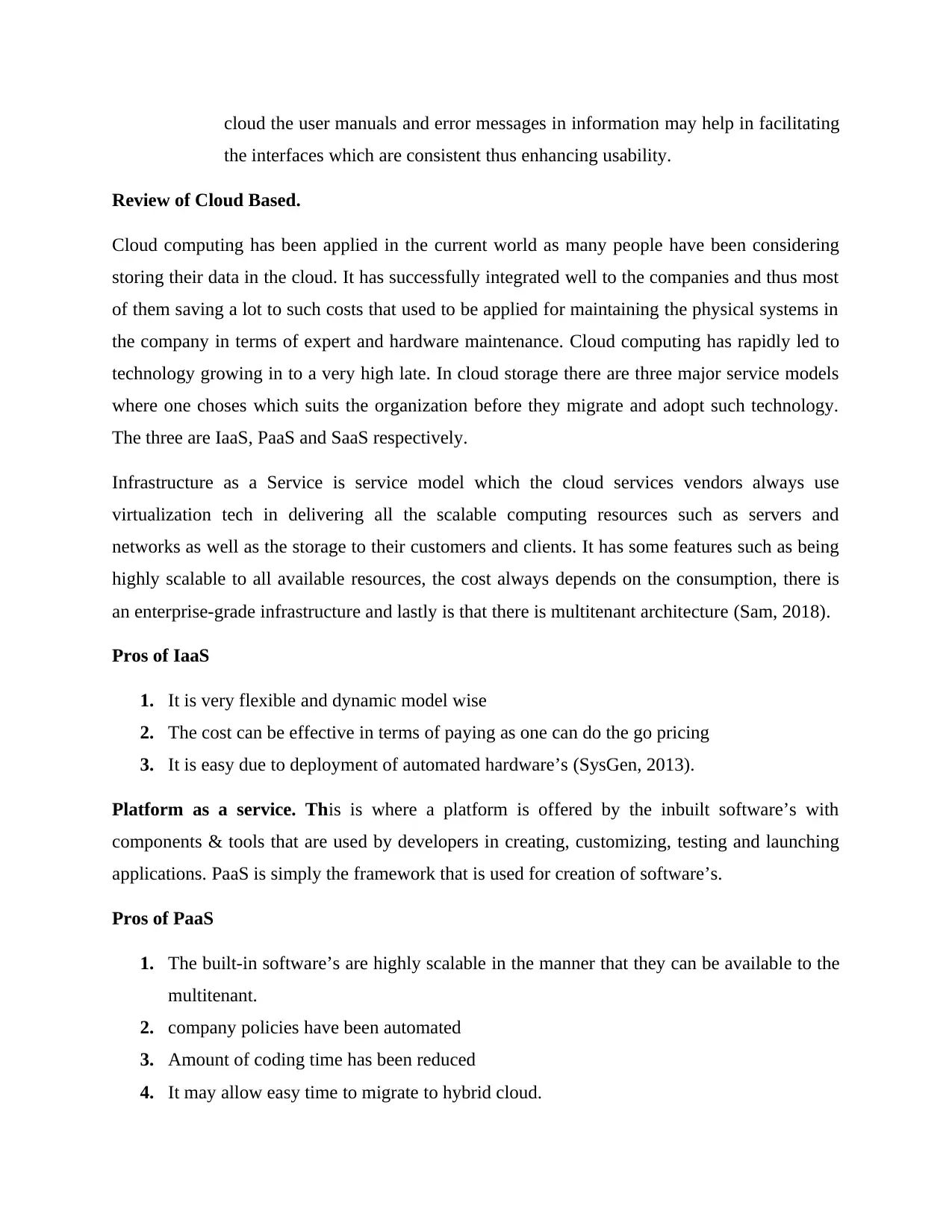
cloud the user manuals and error messages in information may help in facilitating
the interfaces which are consistent thus enhancing usability.
Review of Cloud Based.
Cloud computing has been applied in the current world as many people have been considering
storing their data in the cloud. It has successfully integrated well to the companies and thus most
of them saving a lot to such costs that used to be applied for maintaining the physical systems in
the company in terms of expert and hardware maintenance. Cloud computing has rapidly led to
technology growing in to a very high late. In cloud storage there are three major service models
where one choses which suits the organization before they migrate and adopt such technology.
The three are IaaS, PaaS and SaaS respectively.
Infrastructure as a Service is service model which the cloud services vendors always use
virtualization tech in delivering all the scalable computing resources such as servers and
networks as well as the storage to their customers and clients. It has some features such as being
highly scalable to all available resources, the cost always depends on the consumption, there is
an enterprise-grade infrastructure and lastly is that there is multitenant architecture (Sam, 2018).
Pros of IaaS
1. It is very flexible and dynamic model wise
2. The cost can be effective in terms of paying as one can do the go pricing
3. It is easy due to deployment of automated hardware’s (SysGen, 2013).
Platform as a service. This is where a platform is offered by the inbuilt software’s with
components & tools that are used by developers in creating, customizing, testing and launching
applications. PaaS is simply the framework that is used for creation of software’s.
Pros of PaaS
1. The built-in software’s are highly scalable in the manner that they can be available to the
multitenant.
2. company policies have been automated
3. Amount of coding time has been reduced
4. It may allow easy time to migrate to hybrid cloud.
the interfaces which are consistent thus enhancing usability.
Review of Cloud Based.
Cloud computing has been applied in the current world as many people have been considering
storing their data in the cloud. It has successfully integrated well to the companies and thus most
of them saving a lot to such costs that used to be applied for maintaining the physical systems in
the company in terms of expert and hardware maintenance. Cloud computing has rapidly led to
technology growing in to a very high late. In cloud storage there are three major service models
where one choses which suits the organization before they migrate and adopt such technology.
The three are IaaS, PaaS and SaaS respectively.
Infrastructure as a Service is service model which the cloud services vendors always use
virtualization tech in delivering all the scalable computing resources such as servers and
networks as well as the storage to their customers and clients. It has some features such as being
highly scalable to all available resources, the cost always depends on the consumption, there is
an enterprise-grade infrastructure and lastly is that there is multitenant architecture (Sam, 2018).
Pros of IaaS
1. It is very flexible and dynamic model wise
2. The cost can be effective in terms of paying as one can do the go pricing
3. It is easy due to deployment of automated hardware’s (SysGen, 2013).
Platform as a service. This is where a platform is offered by the inbuilt software’s with
components & tools that are used by developers in creating, customizing, testing and launching
applications. PaaS is simply the framework that is used for creation of software’s.
Pros of PaaS
1. The built-in software’s are highly scalable in the manner that they can be available to the
multitenant.
2. company policies have been automated
3. Amount of coding time has been reduced
4. It may allow easy time to migrate to hybrid cloud.
⊘ This is a preview!⊘
Do you want full access?
Subscribe today to unlock all pages.

Trusted by 1+ million students worldwide

5. The expenses will be reduced in terms of creation, test and launch of applications
SaaS (Software as a Service) is the most common category of most applied cloud computing
service model. In SaaS it offers users with access to the software in the cloud and thus users will
not need to have to download and install the applications of SaaS in the local devices and this
will lead to them being in need of plugins.
Advantages of SaaS
There is no cost of hardware’s
The setup costs initialized at the beginning is not there
Upgrades are automatic
There is compatibility of cross-devices.
Model of the pay-as-you is applied.
There is scalability
Easy to customize
SDLC Approaches
Software development lifecycle is that process that must be followed by the software industry
in designing, developing and testing the software quality. The main aim is designing, developing
and testing the software with the aim of producing software of high quality and that within the
specifies budget and much more within the estimated time given in the project schedule
preparation.
Predictive approach.
The classical and good example of predictive approach is that of the waterfall model that follows
set of phases flowing in a definable manner (Johnson, 2015). It is usually presented from the
requirements- Designing-constructing-integrating-testing-install and maintenance.
Pros and Cons of Predictive approach.
Pros Cons
It is very easy to understand the sequence of
steps and thus making it very easy to follow.
In the predictive SDLC one cannot work on
the software working until the last phase of
SaaS (Software as a Service) is the most common category of most applied cloud computing
service model. In SaaS it offers users with access to the software in the cloud and thus users will
not need to have to download and install the applications of SaaS in the local devices and this
will lead to them being in need of plugins.
Advantages of SaaS
There is no cost of hardware’s
The setup costs initialized at the beginning is not there
Upgrades are automatic
There is compatibility of cross-devices.
Model of the pay-as-you is applied.
There is scalability
Easy to customize
SDLC Approaches
Software development lifecycle is that process that must be followed by the software industry
in designing, developing and testing the software quality. The main aim is designing, developing
and testing the software with the aim of producing software of high quality and that within the
specifies budget and much more within the estimated time given in the project schedule
preparation.
Predictive approach.
The classical and good example of predictive approach is that of the waterfall model that follows
set of phases flowing in a definable manner (Johnson, 2015). It is usually presented from the
requirements- Designing-constructing-integrating-testing-install and maintenance.
Pros and Cons of Predictive approach.
Pros Cons
It is very easy to understand the sequence of
steps and thus making it very easy to follow.
In the predictive SDLC one cannot work on
the software working until the last phase of
Paraphrase This Document
Need a fresh take? Get an instant paraphrase of this document with our AI Paraphraser
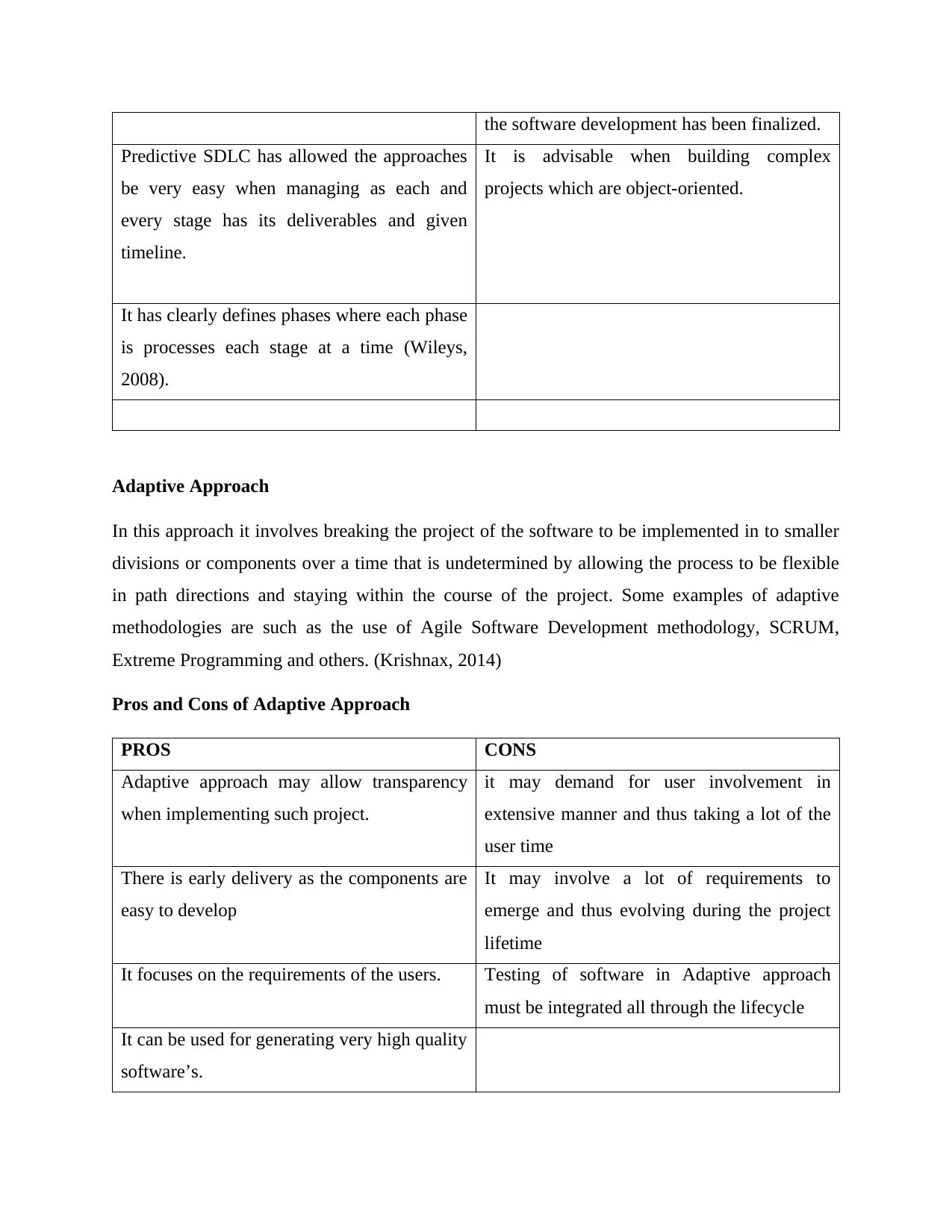
the software development has been finalized.
Predictive SDLC has allowed the approaches
be very easy when managing as each and
every stage has its deliverables and given
timeline.
It is advisable when building complex
projects which are object-oriented.
It has clearly defines phases where each phase
is processes each stage at a time (Wileys,
2008).
Adaptive Approach
In this approach it involves breaking the project of the software to be implemented in to smaller
divisions or components over a time that is undetermined by allowing the process to be flexible
in path directions and staying within the course of the project. Some examples of adaptive
methodologies are such as the use of Agile Software Development methodology, SCRUM,
Extreme Programming and others. (Krishnax, 2014)
Pros and Cons of Adaptive Approach
PROS CONS
Adaptive approach may allow transparency
when implementing such project.
it may demand for user involvement in
extensive manner and thus taking a lot of the
user time
There is early delivery as the components are
easy to develop
It may involve a lot of requirements to
emerge and thus evolving during the project
lifetime
It focuses on the requirements of the users. Testing of software in Adaptive approach
must be integrated all through the lifecycle
It can be used for generating very high quality
software’s.
Predictive SDLC has allowed the approaches
be very easy when managing as each and
every stage has its deliverables and given
timeline.
It is advisable when building complex
projects which are object-oriented.
It has clearly defines phases where each phase
is processes each stage at a time (Wileys,
2008).
Adaptive Approach
In this approach it involves breaking the project of the software to be implemented in to smaller
divisions or components over a time that is undetermined by allowing the process to be flexible
in path directions and staying within the course of the project. Some examples of adaptive
methodologies are such as the use of Agile Software Development methodology, SCRUM,
Extreme Programming and others. (Krishnax, 2014)
Pros and Cons of Adaptive Approach
PROS CONS
Adaptive approach may allow transparency
when implementing such project.
it may demand for user involvement in
extensive manner and thus taking a lot of the
user time
There is early delivery as the components are
easy to develop
It may involve a lot of requirements to
emerge and thus evolving during the project
lifetime
It focuses on the requirements of the users. Testing of software in Adaptive approach
must be integrated all through the lifecycle
It can be used for generating very high quality
software’s.

Recommendations
Adaptive Software Development Lifecycle approach will be the best method to be applied by
health care in their project of migrating to cloud based solutions. There will be extensive
involvement of employees working in the healthcare when implementing the system. System
completeness will be very key by checking if the user requirements are met in each and every
stage unlike in predictive SDLC approach where they can only test the system after the final
stage. This has helped in developing of the systems in rapid manner as the system does some
speculation and iterate the requirements for you.
Adaptive Software Development Lifecycle approach will be the best method to be applied by
health care in their project of migrating to cloud based solutions. There will be extensive
involvement of employees working in the healthcare when implementing the system. System
completeness will be very key by checking if the user requirements are met in each and every
stage unlike in predictive SDLC approach where they can only test the system after the final
stage. This has helped in developing of the systems in rapid manner as the system does some
speculation and iterate the requirements for you.
⊘ This is a preview!⊘
Do you want full access?
Subscribe today to unlock all pages.

Trusted by 1+ million students worldwide
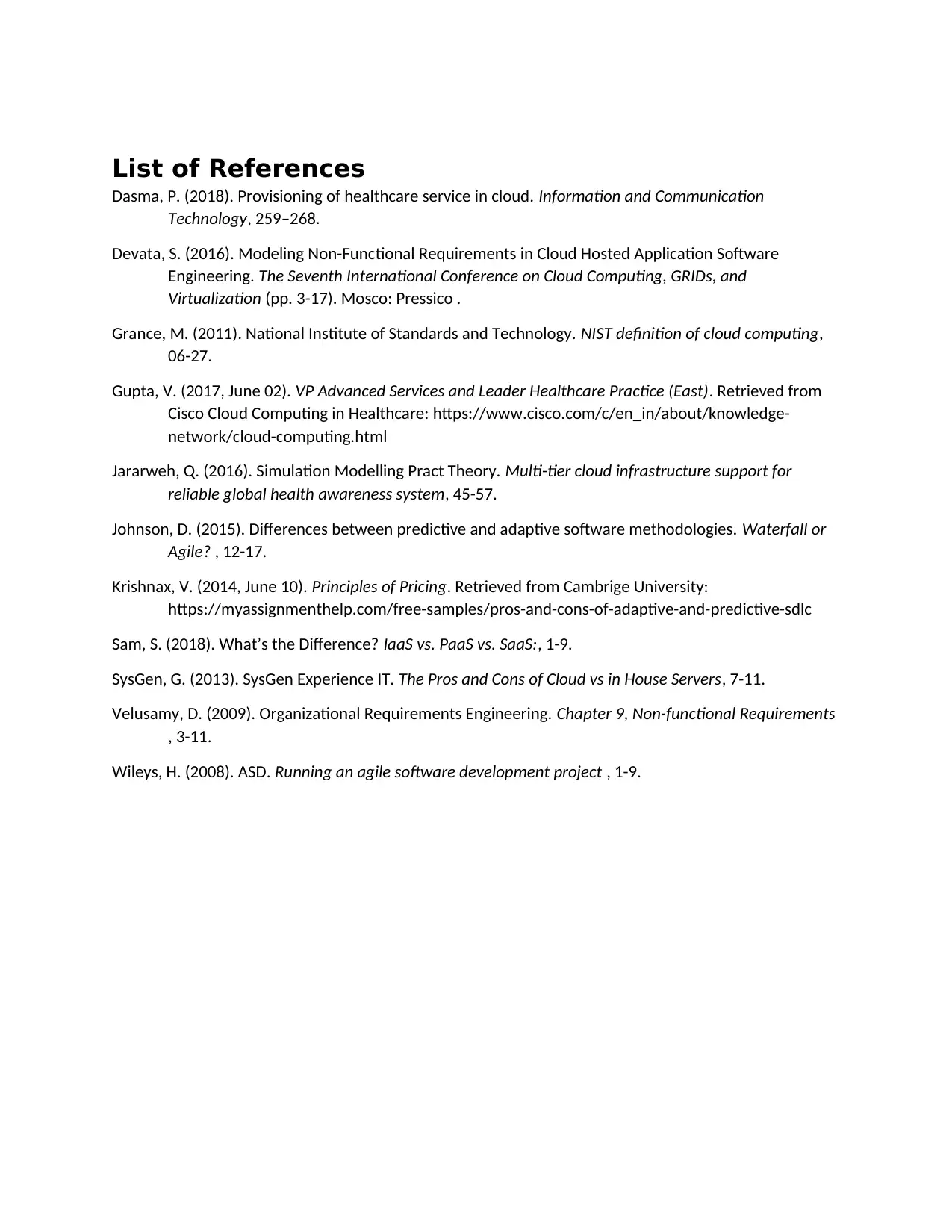
List of References
Dasma, P. (2018). Provisioning of healthcare service in cloud. Information and Communication
Technology, 259–268.
Devata, S. (2016). Modeling Non-Functional Requirements in Cloud Hosted Application Software
Engineering. The Seventh International Conference on Cloud Computing, GRIDs, and
Virtualization (pp. 3-17). Mosco: Pressico .
Grance, M. (2011). National Institute of Standards and Technology. NIST definition of cloud computing,
06-27.
Gupta, V. (2017, June 02). VP Advanced Services and Leader Healthcare Practice (East). Retrieved from
Cisco Cloud Computing in Healthcare: https://www.cisco.com/c/en_in/about/knowledge-
network/cloud-computing.html
Jararweh, Q. (2016). Simulation Modelling Pract Theory. Multi-tier cloud infrastructure support for
reliable global health awareness system, 45-57.
Johnson, D. (2015). Differences between predictive and adaptive software methodologies. Waterfall or
Agile? , 12-17.
Krishnax, V. (2014, June 10). Principles of Pricing. Retrieved from Cambrige University:
https://myassignmenthelp.com/free-samples/pros-and-cons-of-adaptive-and-predictive-sdlc
Sam, S. (2018). What’s the Difference? IaaS vs. PaaS vs. SaaS:, 1-9.
SysGen, G. (2013). SysGen Experience IT. The Pros and Cons of Cloud vs in House Servers, 7-11.
Velusamy, D. (2009). Organizational Requirements Engineering. Chapter 9, Non-functional Requirements
, 3-11.
Wileys, H. (2008). ASD. Running an agile software development project , 1-9.
Dasma, P. (2018). Provisioning of healthcare service in cloud. Information and Communication
Technology, 259–268.
Devata, S. (2016). Modeling Non-Functional Requirements in Cloud Hosted Application Software
Engineering. The Seventh International Conference on Cloud Computing, GRIDs, and
Virtualization (pp. 3-17). Mosco: Pressico .
Grance, M. (2011). National Institute of Standards and Technology. NIST definition of cloud computing,
06-27.
Gupta, V. (2017, June 02). VP Advanced Services and Leader Healthcare Practice (East). Retrieved from
Cisco Cloud Computing in Healthcare: https://www.cisco.com/c/en_in/about/knowledge-
network/cloud-computing.html
Jararweh, Q. (2016). Simulation Modelling Pract Theory. Multi-tier cloud infrastructure support for
reliable global health awareness system, 45-57.
Johnson, D. (2015). Differences between predictive and adaptive software methodologies. Waterfall or
Agile? , 12-17.
Krishnax, V. (2014, June 10). Principles of Pricing. Retrieved from Cambrige University:
https://myassignmenthelp.com/free-samples/pros-and-cons-of-adaptive-and-predictive-sdlc
Sam, S. (2018). What’s the Difference? IaaS vs. PaaS vs. SaaS:, 1-9.
SysGen, G. (2013). SysGen Experience IT. The Pros and Cons of Cloud vs in House Servers, 7-11.
Velusamy, D. (2009). Organizational Requirements Engineering. Chapter 9, Non-functional Requirements
, 3-11.
Wileys, H. (2008). ASD. Running an agile software development project , 1-9.
1 out of 10
Related Documents
Your All-in-One AI-Powered Toolkit for Academic Success.
+13062052269
info@desklib.com
Available 24*7 on WhatsApp / Email
![[object Object]](/_next/static/media/star-bottom.7253800d.svg)
Unlock your academic potential
Copyright © 2020–2025 A2Z Services. All Rights Reserved. Developed and managed by ZUCOL.




